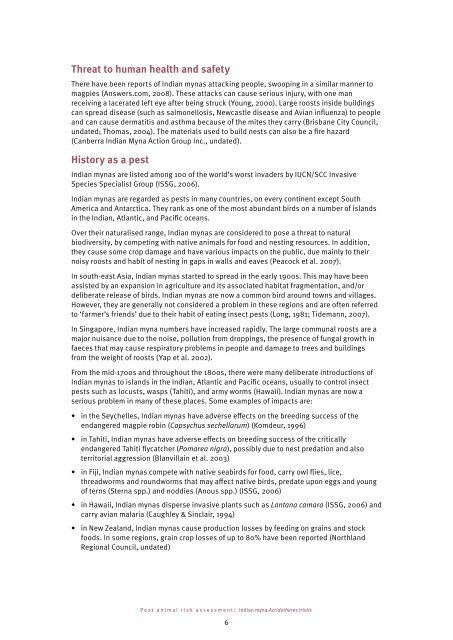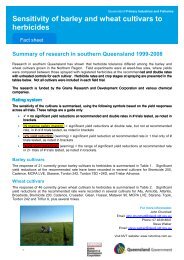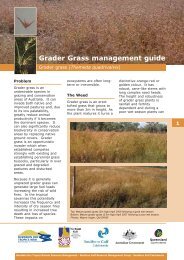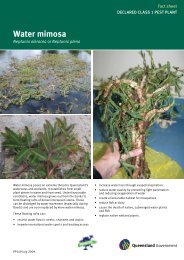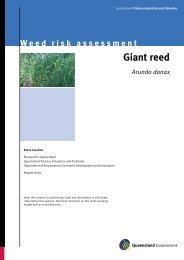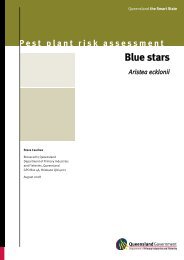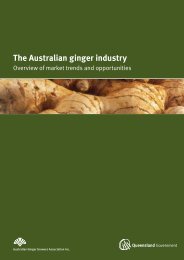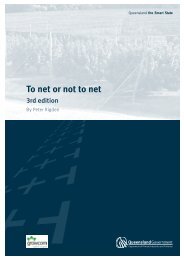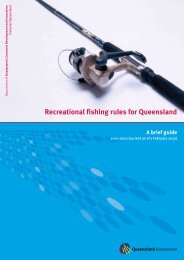Indian myna pest risk assessment - Department of Primary Industries
Indian myna pest risk assessment - Department of Primary Industries
Indian myna pest risk assessment - Department of Primary Industries
You also want an ePaper? Increase the reach of your titles
YUMPU automatically turns print PDFs into web optimized ePapers that Google loves.
Threat to human health and safety<br />
There have been reports <strong>of</strong> <strong>Indian</strong> <strong>myna</strong>s attacking people, swooping in a similar manner to<br />
magpies (Answers.com, 2008). These attacks can cause serious injury, with one man<br />
receiving a lacerated left eye after being struck (Young, 2000). Large roosts inside buildings<br />
can spread disease (such as salmonellosis, Newcastle disease and Avian influenza) to people<br />
and can cause dermatitis and asthma because <strong>of</strong> the mites they carry (Brisbane City Council,<br />
undated; Thomas, 2004). The materials used to build nests can also be a fire hazard<br />
(Canberra <strong>Indian</strong> Myna Action Group Inc., undated).<br />
History as a <strong>pest</strong><br />
<strong>Indian</strong> <strong>myna</strong>s are listed among 100 <strong>of</strong> the world’s worst invaders by IUCN/SCC Invasive<br />
Species Specialist Group (ISSG, 2006).<br />
<strong>Indian</strong> <strong>myna</strong>s are regarded as <strong>pest</strong>s in many countries, on every continent except South<br />
America and Antarctica. They rank as one <strong>of</strong> the most abundant birds on a number <strong>of</strong> islands<br />
in the <strong>Indian</strong>, Atlantic, and Pacific oceans.<br />
Over their naturalised range, <strong>Indian</strong> <strong>myna</strong>s are considered to pose a threat to natural<br />
biodiversity, by competing with native animals for food and nesting resources. In addition,<br />
they cause some crop damage and have various impacts on the public, due mainly to their<br />
noisy roosts and habit <strong>of</strong> nesting in gaps in walls and eaves (Peacock et al. 2007).<br />
In south-east Asia, <strong>Indian</strong> <strong>myna</strong>s started to spread in the early 1900s. This may have been<br />
assisted by an expansion in agriculture and its associated habitat fragmentation, and/or<br />
deliberate release <strong>of</strong> birds. <strong>Indian</strong> <strong>myna</strong>s are now a common bird around towns and villages.<br />
However, they are generally not considered a problem in these regions and are <strong>of</strong>ten referred<br />
to ‘farmer’s friends’ due to their habit <strong>of</strong> eating insect <strong>pest</strong>s (Long, 1981; Tidemann, 2007).<br />
In Singapore, <strong>Indian</strong> <strong>myna</strong> numbers have increased rapidly. The large communal roosts are a<br />
major nuisance due to the noise, pollution from droppings, the presence <strong>of</strong> fungal growth in<br />
faeces that may cause respiratory problems in people and damage to trees and buildings<br />
from the weight <strong>of</strong> roosts (Yap et al. 2002).<br />
From the mid-1700s and throughout the 1800s, there were many deliberate introductions <strong>of</strong><br />
<strong>Indian</strong> <strong>myna</strong>s to islands in the <strong>Indian</strong>, Atlantic and Pacific oceans, usually to control insect<br />
<strong>pest</strong>s such as locusts, wasps (Tahiti), and army worms (Hawaii). <strong>Indian</strong> <strong>myna</strong>s are now a<br />
serious problem in many <strong>of</strong> these places. Some examples <strong>of</strong> impacts are:<br />
• in the Seychelles, <strong>Indian</strong> <strong>myna</strong>s have adverse effects on the breeding success <strong>of</strong> the<br />
endangered magpie robin (Copsychus sechellarum) (Komdeur, 1996)<br />
• in Tahiti, <strong>Indian</strong> <strong>myna</strong>s have adverse effects on breeding success <strong>of</strong> the critically<br />
endangered Tahiti flycatcher (Pomarea nigra), possibly due to nest predation and also<br />
territorial aggression (Blanvillain et al. 2003)<br />
• in Fiji, <strong>Indian</strong> <strong>myna</strong>s compete with native seabirds for food, carry owl flies, lice,<br />
threadworms and roundworms that may affect native birds, predate upon eggs and young<br />
<strong>of</strong> terns (Sterna spp.) and noddies (Anous spp.) (ISSG, 2006)<br />
• in Hawaii, <strong>Indian</strong> <strong>myna</strong>s disperse invasive plants such as Lantana camara (ISSG, 2006) and<br />
carry avian malaria (Caughley & Sinclair, 1994)<br />
• in New Zealand, <strong>Indian</strong> <strong>myna</strong>s cause production losses by feeding on grains and stock<br />
foods. In some regions, grain crop losses <strong>of</strong> up to 80% have been reported (Northland<br />
Regional Council, undated)<br />
P e s t a n i m a l r i s k a s s e s s m e n t : <strong>Indian</strong> <strong>myna</strong> Acridotheres tristis<br />
6


